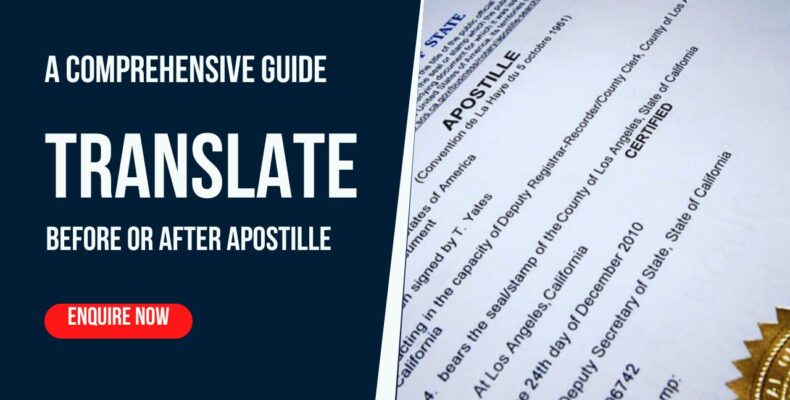Navigating the intricacies of legal documentation, especially for international use, can be challenging. One common question is whether to translate documents before or after obtaining an apostille. Understanding the differences between sworn translations, certified translations, and notarized documents, and how they interact with the apostille process, is crucial for ensuring your documents are correctly prepared and accepted abroad.
Key Takeaways
- Understand the differences between sworn translations, certified translations, and notarized documents.
- Learn the best practices for translating documents in the context of obtaining an apostille.
- Gain insights into the Hague Apostille Convention and its impact on international documentation.
What Is an Apostille and Why Do You Need It?
An apostille is a form of authentication issued to documents for use in countries that participate in the Hague Apostille Convention. This international treaty simplifies the process of verifying the authenticity of documents to be used abroad. Common documents requiring an apostille include marriage certificates, affidavits, and other notarized documents.
Get Your Documents Apostilled with Ease in Oregon
Ensure your important documents are recognized internationally with our professional apostille authentication oregon services. Whether it’s for marriage certificates, affidavits, or other notarized documents, our expert team is here to guide you through every step of the process. Contact us today to streamline your apostille needs and ensure your documents are correctly authenticated for use abroad.
Get Started Now:
- Fast and Reliable Service
- Expert Guidance
- Secure and Confidential Handling
Contact Us Today to Get Your Apostille Authentication Process Started!
Sworn Translations vs. Certified Translations vs. Notarized Documents
Sworn Translations
A sworn translation is performed by a translator who is authorized by a government body to translate and certify the accuracy of documents. These translations are often required for legal documents and are recognized in countries that adhere to the Hague Convention.
Certified Translations
Certified translations come with a statement from the translator attesting to the accuracy and completeness of the translation. Unlike sworn translations, certified translations are not always recognized by foreign authorities unless notarized.
Notarized Documents
Notarized documents have been authenticated by a notary public, a legally authorized official. These documents may require further certification, such as an apostille, for international use.
When to Translate: Before or After Apostille?
Before Obtaining an Apostille
- Consistency in Translation: Translating a document before obtaining an apostille ensures that the translation and the original document match perfectly. This is crucial for maintaining the integrity of the document.
- Ease of Verification: Apostilles authenticate the signature and seal of the notary public, not the content. Therefore, having the translation done first allows both the original and translated documents to be verified simultaneously.
After Obtaining an Apostille
- Specific Requirements: Some countries or institutions may require the apostille to be on the original document before translation to ensure the document’s legitimacy.
- Avoiding Additional Costs: If a translation is done after the apostille, only one translation of the apostille itself may be necessary, potentially reducing costs.
The Apostille Process: Step-by-Step
- Prepare the Document: Ensure the document is complete and ready for apostille.
- Notarization: Have the document notarized by a notary public.
- Apostille Request: Submit the notarized document to the appropriate authority (e.g., Secretary of State) to obtain the apostille.
- Translation (if required after apostille): Translate the document, including the apostille, into the required language.
Key Entities Involved in the Apostille Process
- Hague Apostille Convention: An international treaty that standardizes the process of legalizing documents for use in member countries.
- Notary Public: A legal officer authorized to certify documents.
- Consular Officer: An official who may be involved in the legalization process in some countries.
- Travel.state.gov: The U.S. Department of State’s portal for travel and legal documentation, including apostille information.
FAQs
Q: What is the Hague Apostille Convention? A: The Hague Apostille Convention is an international treaty that simplifies the process of certifying documents for use abroad, ensuring their legitimacy in member countries.
Q: What documents commonly require an apostille? A: Common documents include marriage certificates, birth certificates, affidavits, and other legal and notarized documents.
Q: Can I translate the apostille itself? A: Yes, translations can include the apostille, especially if required by the receiving country or institution.
Q: Do all countries recognize apostilles? A: No, only countries that are signatories to the Hague Apostille Convention recognize apostilles.
Problems and Solutions in the Apostille and Translation Process
Problem: Incorrect Order of Processes
Solution: Always check the specific requirements of the receiving country. Generally, translating before obtaining an apostille ensures consistency and ease of verification.
Problem: Non-recognition of Certified Translations
Solution: If a certified translation is not recognized, consider obtaining a sworn translation or have the translation notarized.
Problem: High Costs
Solution: Plan the process carefully. Translating before obtaining an apostille can sometimes reduce costs by eliminating the need for multiple translations.
Conclusion
Understanding whether to translate before or after obtaining an apostille is essential for ensuring the acceptance of your documents abroad. By familiarizing yourself with the requirements of sworn translations, certified translations, and notarized documents, and following the guidelines of the Hague Apostille Convention, you can navigate this process smoothly and efficiently.


